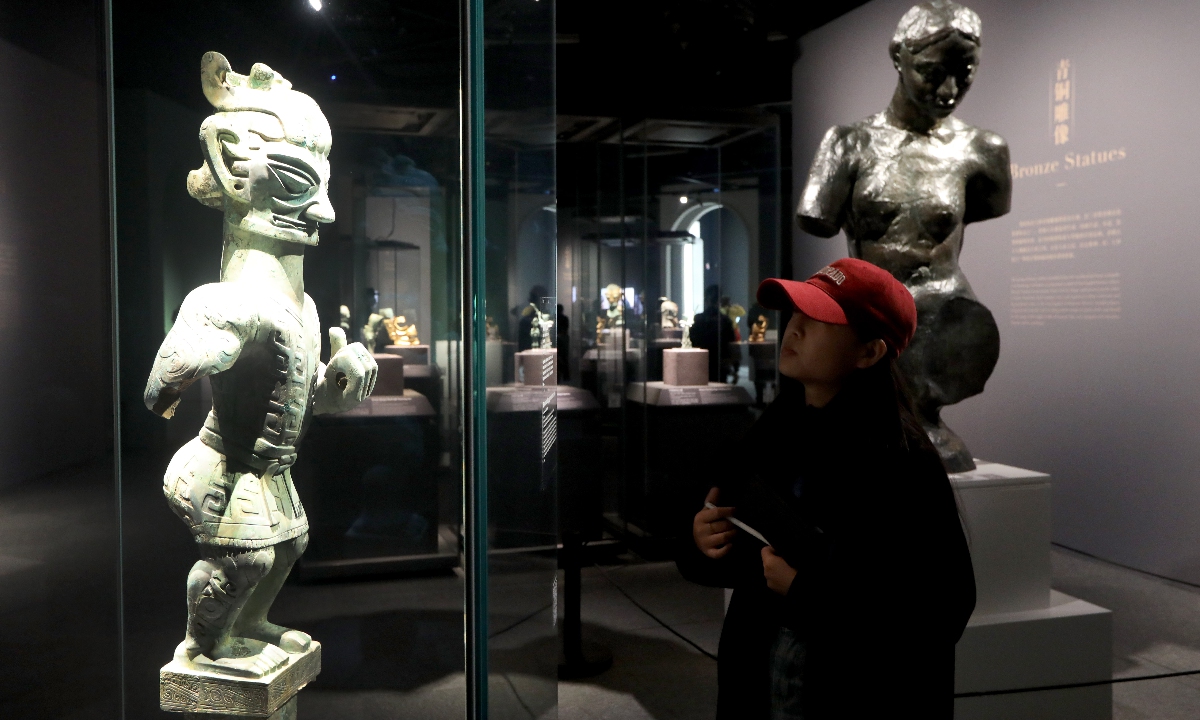
A visitor examines the Bronze Standing Figure Wearing a Skirt, an artifact unearthed from the Sanxingdui Ruins, at the exhibition Glory of Bronze Civilization: A Dialogue between Sanxingdui and Auguste Rodin across Space and Time at the Shanghai University Museum on December 14, 2023. Photo: Chen Xia/GT
Dozens of millennium-old intricate bronzes from China's renowned Sanxingdui Ruins sit in the dim light. Just a few steps away are some representative sculptures of French art giant Auguste Rodin. Coming from completely different continents and eras, they are displayed together in the same exhibition hall in unexpected harmony, bringing visitors a dialogue of civilizations across time and space.
The exhibition,
Glory of Bronze Civilization: A Dialogue between Sanxingdui and Auguste Rodin across Space and Time, kicked off at the Shanghai University Museum to mark the ongoing fifth Shanghai Archaeology Forum, which is being held at the Shanghai University Museum on December 15-18.
It is also a tribute to the upcoming 60th anniversary of the establishment of diplomatic relations between China and France in 2024, according to the hosts.
At the exhibition, visitors can get a close look at 36 ancient Chinese cultural relics, mainly from the 3,000-year-old Sanxingdui Ruins, as well as 21 modern artworks by famous Western artists, like the master sculptor Rodin, according to the museum.
The Sanxingdui civilization and Rodin's sculpture art, though coming from distinct time and space backgrounds, share some interesting similarities, said the museum's director Li Mingbin.
"They both use bronze as the main medium of expression, and both use humans and gods as important objects of creation and expression," Li told the Global Times on Thursday.
"These elements become the internal logical basis of a dialogue between the two."
Li noted the practical significance of the exhibition in promoting mutual learning between Chinese and Western civilizations in the fields of art and archaeology.
Deep in our minds, humans share similar views of the world and life, across time, region, ethnicity and culture, Li said. Therefore, "preserving and inheriting the diverse and colorful cultures of human society is the fundamental purpose and common mission of museums around the world," he added.
Li introduced some of the must-see exhibits. One is the Bronze Standing Figure Wearing a Skirt, which was unearthed from a sacrificial pit at Sanxingdui in 2022. The figure has upright hair, a square face, broad eyebrows, large eyes with upturned corners, a thick neck and muscular arms. He embodies great physical strength, suggesting a unique role in sacrificial ceremonies.
Another highlight is Torso of the Muse Whistler, one of Rodin's representative works. In 1905, Rodin was commissioned to create a memorial statue for US painter James Whistler. Instead of creating a realistic or descriptive statue of Whistler, Rodin chose the image of the Muse to symbolize Whistler's reputation in the art world.
The Rodin sculptures are exhibited with the help of Rodin Art Center (Rodin Museum China Branch), a sister location of the Paris-based Rodin Museum.
The center's director Wu Jing, a French collector of Chinese ancestry, said she was quite impressed by the "invisible energy" produced in the exhibition space by the two types of artworks and civilizations, which are amazing and awe-inspiring.
"Sanxingdui bronzes and Rodin sculptures are not only the unique creations of China and France, but also precious cultural heritages belonging to all mankind," Wu told the Global Times on Thursday.
"Their value and ideological characteristics far exceed geographical restrictions, being a valuable example of the inclusiveness, integration and innovation of human civilizations," she said.
To celebrate the 60th anniversary of the establishment of diplomatic relations between China and France in 2024, Wu said many museums and cultural institutions of the two countries have started to plan a series of cultural exchange activities.
Wu said she is proud that Rodin's artworks are exhibited at the exhibition. "I hope that more cultural exchange activities will take place in the context of China-France friendship and cultural mutual learning," she said.
The exhibition is jointly sponsored by SHU and the Sichuan Provincial Cultural Heritage Administration. It is co-organized by the Shanghai University Museum, Rodin Art Center, Sichuan Provincial Cultural Relics and Archaeology Research Institute, the Sichuan Museum, Sanxingdui Museum and Jinsha Site Museum.
It kicked off on December 13 and will run until February 1, 2024.




